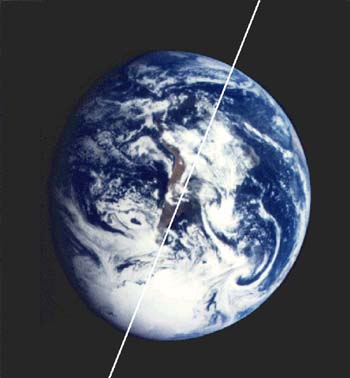Earth's axis displacement to result in monstrous global changes
As the core nears the mantle of Earth, the number of earthquakes, tsunamis and volcano eruptions increases
The core of our planet is directly connected with the Earth's magnetic field. Scientists noticed back in the 17th century that the field was constantly changing. The Earth's magnetic intensity has reduced by almost five percent over the recent hundred of years. The tempo implies that the field will totally disappear already in 2000. The geomagnetic field is a peculiar screen, which protects the planet from space radiation. If the screen is removed, the planet will be attacked with a strong radiation current, which will either kill all living beings on Earth or cause various mutations in the biosphere. 
There is another danger too. It was noticed in 1829 that the Earth's inner core was displaced by 252 kilometers against the axis towards the Pacific Ocean. The displacement had increased to 451 kilometers by 1965. If the core continues moving towards the Earth's surface, the planet will simply turn over itself in space someday.
The displacement of the Earth's axis occurred in ancient times too. The evidence of it can be found in both numerous historical sources and modern scientific researches. Archaeologists have recently uncovered a sundial in Egypt, which could be used only in a country located in latitude 15, although Egypt is situated on latitude 25-30. Astronomical tables contain the information, which says that Babylon used to be situated a little bit far to the north in comparison with up-to-date ruins of the city.
One of the recent displacements of the Earth's axis occurred during the Flood. Legends about the Flood can be found with almost every nation of the world: the descriptions of the disaster are almost identical everywhere. The Bible says that the Apocalypse would start with the voice of the Lord that every human being will hear. Egyptians used to say that the Great Sphinx was the father of horror and fear. One of Egyptian legends says that the whole world will shudder, when the Sphinx starts roaring with laughter. All those stories describe the sound that the Earth's core produces when it touches the mantle. The sound can be heard in various parts of the world from time to time; some nations even have specific terms for it.
As the core nears the mantle of Earth, the number of earthquakes, tsunamis and volcano eruptions increases, especially in the areas of the Pacific and Indian oceans, adjacent to the crust break. A displacement of the earth's axis will inevitably result in climate changes. The eruption of volcanic gases and ashes will darken the atmosphere and reduce the power of the solar energy. A contact between the earth's core and mantle will lead to catastrophic consequences on the surface of the planet – mammoth earthquakes and tsunamis.
The global danger to life on the blue planet is quite real. Needless to mention that the humanity is absolutely unable to prevent it. Aleksei Nikolayev, a specialist for earthquakes from the Russian Academy of Sciences, says that the underground life of the planet conceals a lot of mysteries indeed. “There is no need to panic, though. The parameters of the Earth's rotation have already changed before. The recent tsunami in Southeast Asia wobbled the earth's axis and increased the speed of the planet's rotation. The day became three microseconds shorter. The speed of the planet's rotation is not permanent: there are seasonal and even daily variations, which are connected with underground processes, air movement and sea currents. The axis wobbles for about a meter every month, but it does not lead to any tremendous and horrible global changes. Alterations of the planet's magnetic field are not a reason to panic either: it is a natural dynamic process. There will be no need to worry for four billion years, until the Sun runs out of its power,” the specialist believes.
Subscribe to Pravda.Ru Telegram channel, Facebook, RSS!




